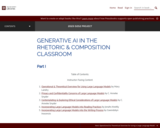
This two-part resource is designed to support instructors and students as they navigate the presence of generative AI tools, specifically Large Language Models (LLMs) such as ChatGPT, in the rhetoric and composition classroom. Part I of this resource offers an instructor-focused introduction to what LLMs are and how they operate, as well as an in-depth exploration of the privacy concerns and ethical considerations related to using a tool like ChatGPT. Additionally, Part I provides insights on the practical application of LLMs within the realm of reading and writing in the rhetoric and composition classroom, while promoting a modified stasis theory as a strategy for evaluating any generated output.
Part II of this resource offers student-focused tutorials that demonstrate how ChatGPT can augment the writing process for assignments commonly given in a rhetoric and composition course. These tutorials cover the evaluation essay, rhetorical analysis, Rogerian argument, annotated bibliography, and research essay—all while promoting the responsible and ethical use of AI in writing and research. With this comprehensive resource, instructors and students can not only build confidence in their understanding of generative AI within academia, but also build digital literacy that will serve them in the world beyond.
- Subject:
- Composition and Rhetoric
- English Language Arts
- Material Type:
- Module
- Author:
- Anneke Snyder
- Gwendolyn Inocencio
- Irene Ai
- Jonahs Kneitly
- Mary (Perkins) Landry
- Shweta Kailani
- Terri Pantuso
- Date Added:
- 08/21/2023